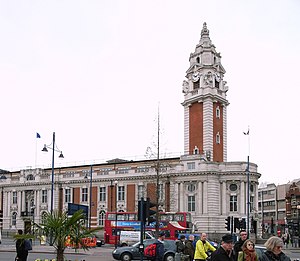Brixton
The Brixton riots in 1981 prompted the Scarnman Report which recommended major changes in policing procedures.
LGBT history
The singer Skin was born in Brixton in 1967.
In the early 1970s a number of GLF supporters lived in squats in Brixton, and formed the South London Gay Community Centre at 78 Railton Road.[1]
From 1992 onwards, Love Muscle was a popular gay night at the Fridge nightclub in Twon Hall Parade.
In 1999, David Copeland planted a nail bomb in Electric Avenue, directed against the local black community, injuring about 50 people, as part of his hate campaign which also included bombs in Brick Lane (directed against the Asian Community) and the Admiral Duncan, Soho, directed against the gay community.
In 2001, Brian Paddick, then police commander for Lambeth, pioneered a more relaxed attitude to the policing of cannabis possession in Brixton.
Lambeth Goldies met in Brixton.
There is a blue plaque to the sexologist Havelock Ellis at Dover Mansions on Canterbury Crescent.
